Environmental Project Management in Construction: Armada Group
VerifiedAdded on 2023/06/14
|7
|1595
|330
Report
AI Summary
This report investigates the role of Environmental Project Management (EPM) in the construction industry, focusing on a case study of Armada Group in the United Arab Emirates. The research addresses the critical need for EPM to mitigate environmental issues that can impact project budgets, schedules, and technical aspects. Employing a mixed-methods approach, the study combines quantitative data from company performance records with qualitative data from interviews with top management. The research targets key informants within Armada Group, utilizing purposive sampling to gather insights on environmental feasibility analysis and its consequences. Data collection involves interview schedules and structured checklists to assess the performance and implications of EPM on project scope, budget, and technical capacity. The study acknowledges limitations such as time constraints and respondent cooperation, while adhering to ethical considerations including obtaining authorizations, ensuring voluntary participation, and maintaining data confidentiality. The findings are presented through frequency distribution tables, providing a clear and unbiased representation of the data, contributing to a better understanding of EPM's importance in the construction sector.
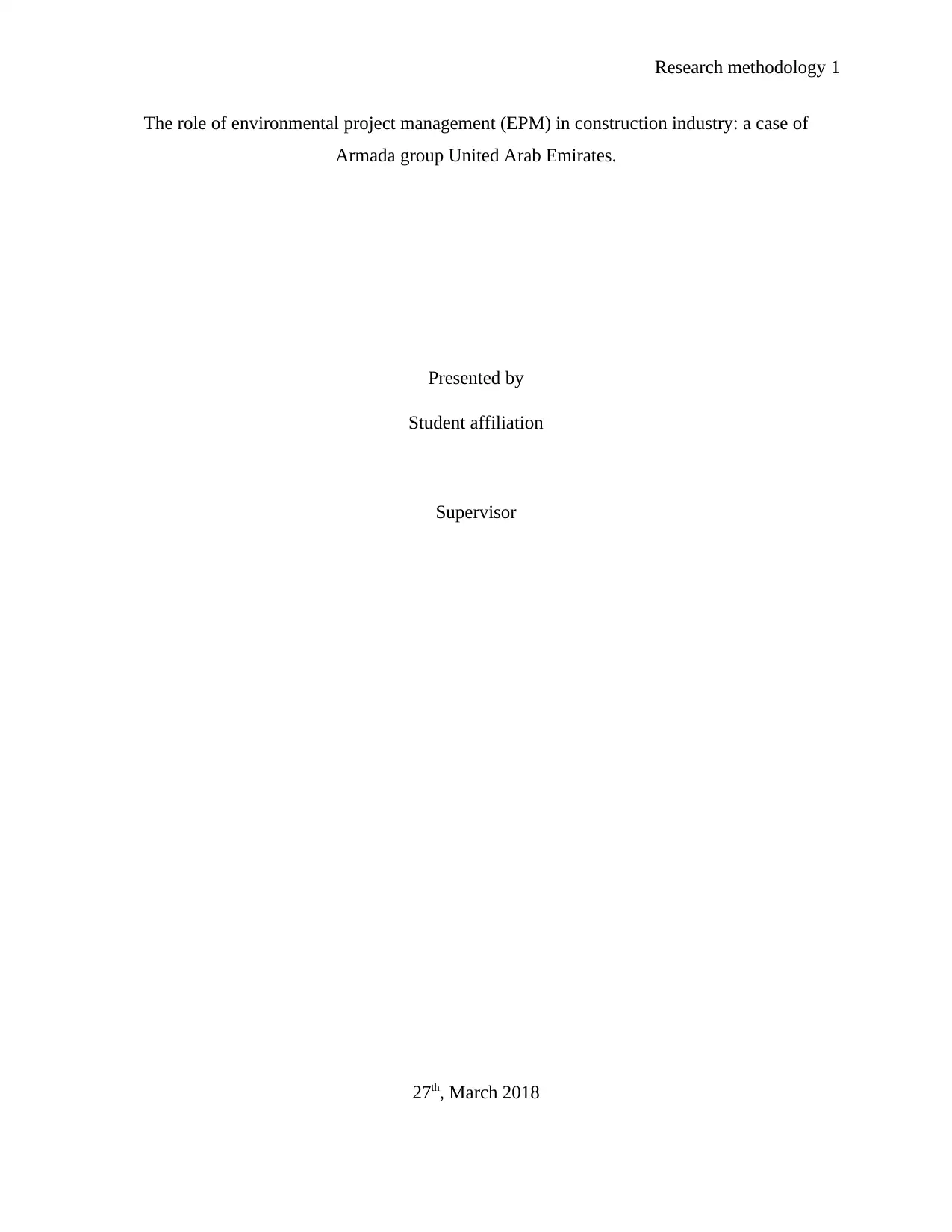
Research methodology 1
The role of environmental project management (EPM) in construction industry: a case of
Armada group United Arab Emirates.
Presented by
Student affiliation
Supervisor
27th, March 2018
The role of environmental project management (EPM) in construction industry: a case of
Armada group United Arab Emirates.
Presented by
Student affiliation
Supervisor
27th, March 2018
Paraphrase This Document
Need a fresh take? Get an instant paraphrase of this document with our AI Paraphraser
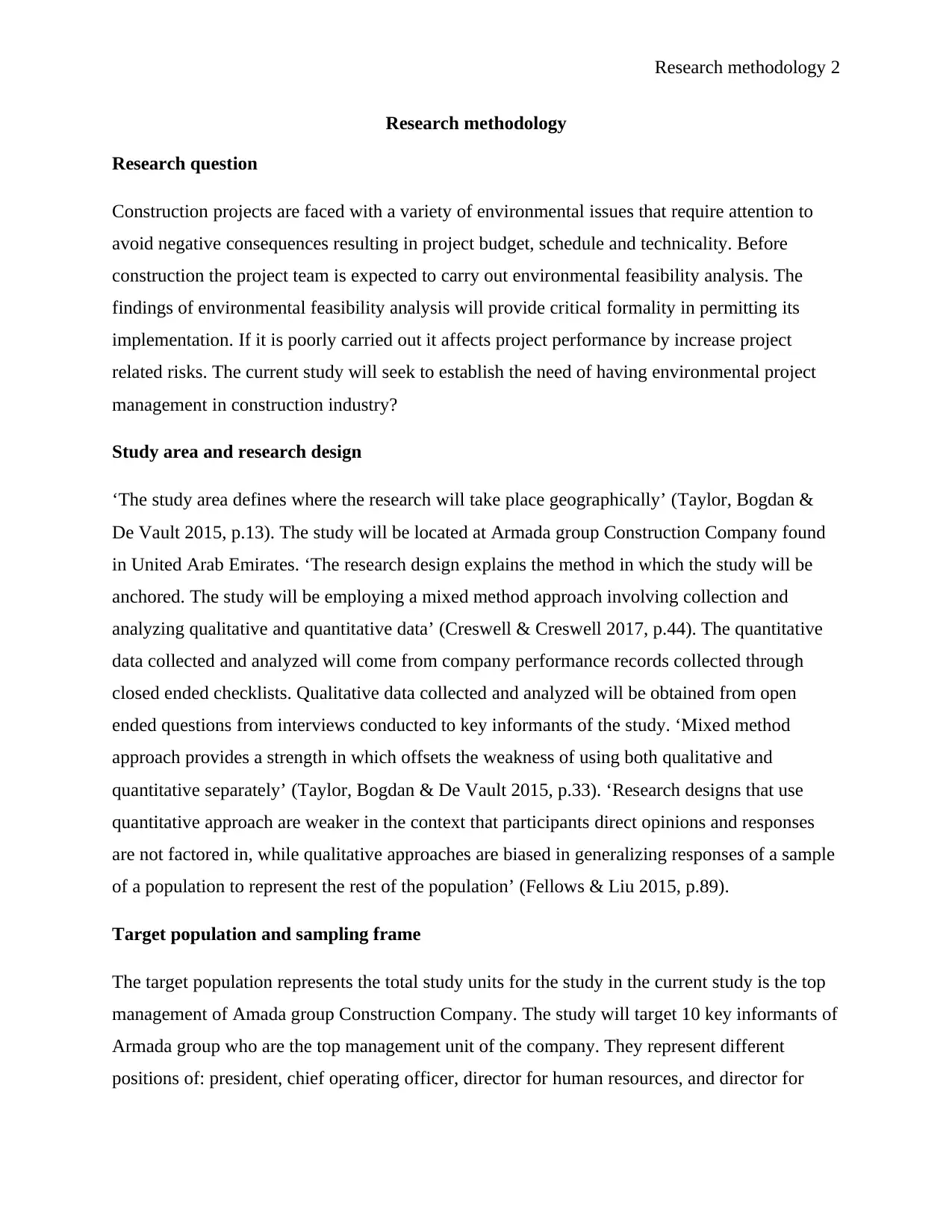
Research methodology 2
Research methodology
Research question
Construction projects are faced with a variety of environmental issues that require attention to
avoid negative consequences resulting in project budget, schedule and technicality. Before
construction the project team is expected to carry out environmental feasibility analysis. The
findings of environmental feasibility analysis will provide critical formality in permitting its
implementation. If it is poorly carried out it affects project performance by increase project
related risks. The current study will seek to establish the need of having environmental project
management in construction industry?
Study area and research design
‘The study area defines where the research will take place geographically’ (Taylor, Bogdan &
De Vault 2015, p.13). The study will be located at Armada group Construction Company found
in United Arab Emirates. ‘The research design explains the method in which the study will be
anchored. The study will be employing a mixed method approach involving collection and
analyzing qualitative and quantitative data’ (Creswell & Creswell 2017, p.44). The quantitative
data collected and analyzed will come from company performance records collected through
closed ended checklists. Qualitative data collected and analyzed will be obtained from open
ended questions from interviews conducted to key informants of the study. ‘Mixed method
approach provides a strength in which offsets the weakness of using both qualitative and
quantitative separately’ (Taylor, Bogdan & De Vault 2015, p.33). ‘Research designs that use
quantitative approach are weaker in the context that participants direct opinions and responses
are not factored in, while qualitative approaches are biased in generalizing responses of a sample
of a population to represent the rest of the population’ (Fellows & Liu 2015, p.89).
Target population and sampling frame
The target population represents the total study units for the study in the current study is the top
management of Amada group Construction Company. The study will target 10 key informants of
Armada group who are the top management unit of the company. They represent different
positions of: president, chief operating officer, director for human resources, and director for
Research methodology
Research question
Construction projects are faced with a variety of environmental issues that require attention to
avoid negative consequences resulting in project budget, schedule and technicality. Before
construction the project team is expected to carry out environmental feasibility analysis. The
findings of environmental feasibility analysis will provide critical formality in permitting its
implementation. If it is poorly carried out it affects project performance by increase project
related risks. The current study will seek to establish the need of having environmental project
management in construction industry?
Study area and research design
‘The study area defines where the research will take place geographically’ (Taylor, Bogdan &
De Vault 2015, p.13). The study will be located at Armada group Construction Company found
in United Arab Emirates. ‘The research design explains the method in which the study will be
anchored. The study will be employing a mixed method approach involving collection and
analyzing qualitative and quantitative data’ (Creswell & Creswell 2017, p.44). The quantitative
data collected and analyzed will come from company performance records collected through
closed ended checklists. Qualitative data collected and analyzed will be obtained from open
ended questions from interviews conducted to key informants of the study. ‘Mixed method
approach provides a strength in which offsets the weakness of using both qualitative and
quantitative separately’ (Taylor, Bogdan & De Vault 2015, p.33). ‘Research designs that use
quantitative approach are weaker in the context that participants direct opinions and responses
are not factored in, while qualitative approaches are biased in generalizing responses of a sample
of a population to represent the rest of the population’ (Fellows & Liu 2015, p.89).
Target population and sampling frame
The target population represents the total study units for the study in the current study is the top
management of Amada group Construction Company. The study will target 10 key informants of
Armada group who are the top management unit of the company. They represent different
positions of: president, chief operating officer, director for human resources, and director for
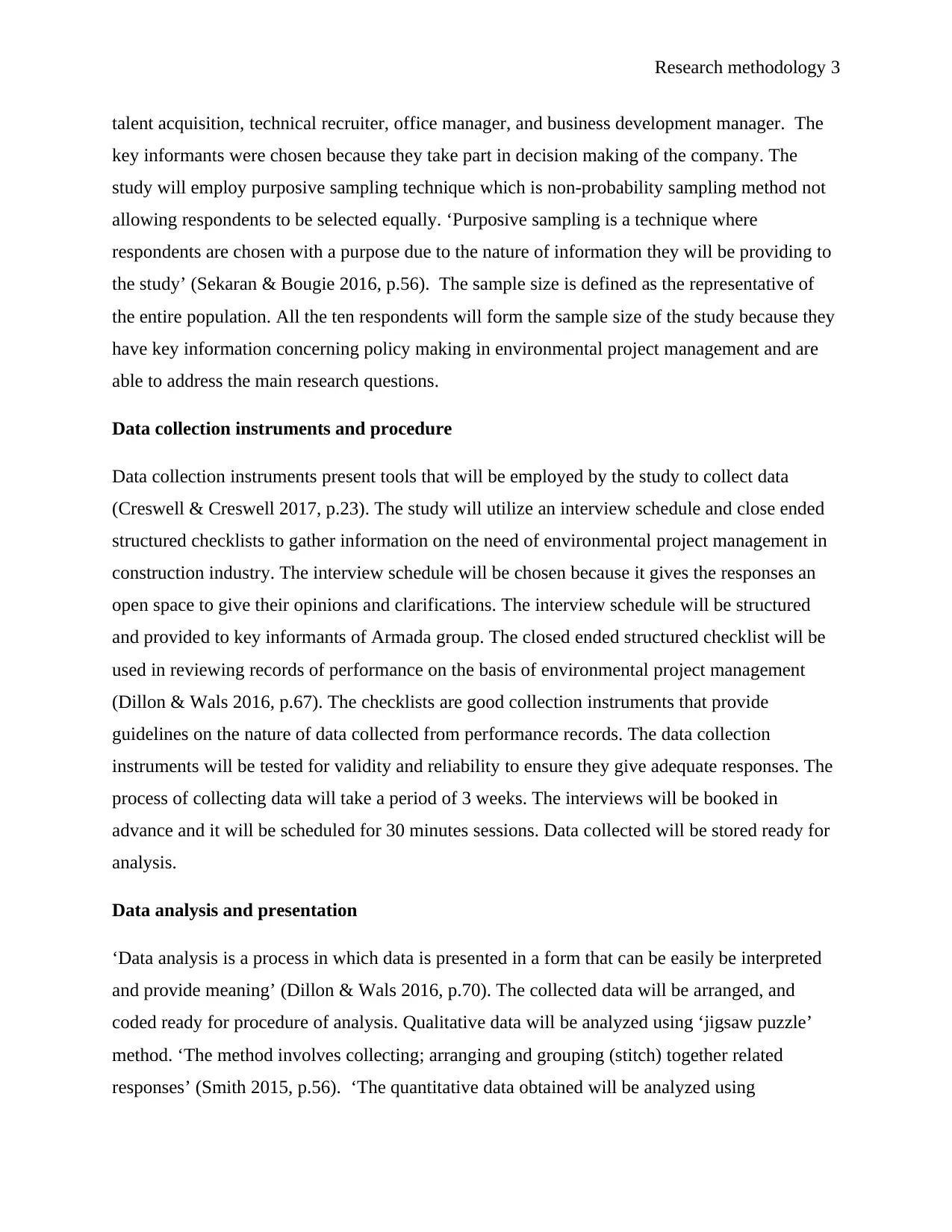
Research methodology 3
talent acquisition, technical recruiter, office manager, and business development manager. The
key informants were chosen because they take part in decision making of the company. The
study will employ purposive sampling technique which is non-probability sampling method not
allowing respondents to be selected equally. ‘Purposive sampling is a technique where
respondents are chosen with a purpose due to the nature of information they will be providing to
the study’ (Sekaran & Bougie 2016, p.56). The sample size is defined as the representative of
the entire population. All the ten respondents will form the sample size of the study because they
have key information concerning policy making in environmental project management and are
able to address the main research questions.
Data collection instruments and procedure
Data collection instruments present tools that will be employed by the study to collect data
(Creswell & Creswell 2017, p.23). The study will utilize an interview schedule and close ended
structured checklists to gather information on the need of environmental project management in
construction industry. The interview schedule will be chosen because it gives the responses an
open space to give their opinions and clarifications. The interview schedule will be structured
and provided to key informants of Armada group. The closed ended structured checklist will be
used in reviewing records of performance on the basis of environmental project management
(Dillon & Wals 2016, p.67). The checklists are good collection instruments that provide
guidelines on the nature of data collected from performance records. The data collection
instruments will be tested for validity and reliability to ensure they give adequate responses. The
process of collecting data will take a period of 3 weeks. The interviews will be booked in
advance and it will be scheduled for 30 minutes sessions. Data collected will be stored ready for
analysis.
Data analysis and presentation
‘Data analysis is a process in which data is presented in a form that can be easily be interpreted
and provide meaning’ (Dillon & Wals 2016, p.70). The collected data will be arranged, and
coded ready for procedure of analysis. Qualitative data will be analyzed using ‘jigsaw puzzle’
method. ‘The method involves collecting; arranging and grouping (stitch) together related
responses’ (Smith 2015, p.56). ‘The quantitative data obtained will be analyzed using
talent acquisition, technical recruiter, office manager, and business development manager. The
key informants were chosen because they take part in decision making of the company. The
study will employ purposive sampling technique which is non-probability sampling method not
allowing respondents to be selected equally. ‘Purposive sampling is a technique where
respondents are chosen with a purpose due to the nature of information they will be providing to
the study’ (Sekaran & Bougie 2016, p.56). The sample size is defined as the representative of
the entire population. All the ten respondents will form the sample size of the study because they
have key information concerning policy making in environmental project management and are
able to address the main research questions.
Data collection instruments and procedure
Data collection instruments present tools that will be employed by the study to collect data
(Creswell & Creswell 2017, p.23). The study will utilize an interview schedule and close ended
structured checklists to gather information on the need of environmental project management in
construction industry. The interview schedule will be chosen because it gives the responses an
open space to give their opinions and clarifications. The interview schedule will be structured
and provided to key informants of Armada group. The closed ended structured checklist will be
used in reviewing records of performance on the basis of environmental project management
(Dillon & Wals 2016, p.67). The checklists are good collection instruments that provide
guidelines on the nature of data collected from performance records. The data collection
instruments will be tested for validity and reliability to ensure they give adequate responses. The
process of collecting data will take a period of 3 weeks. The interviews will be booked in
advance and it will be scheduled for 30 minutes sessions. Data collected will be stored ready for
analysis.
Data analysis and presentation
‘Data analysis is a process in which data is presented in a form that can be easily be interpreted
and provide meaning’ (Dillon & Wals 2016, p.70). The collected data will be arranged, and
coded ready for procedure of analysis. Qualitative data will be analyzed using ‘jigsaw puzzle’
method. ‘The method involves collecting; arranging and grouping (stitch) together related
responses’ (Smith 2015, p.56). ‘The quantitative data obtained will be analyzed using
⊘ This is a preview!⊘
Do you want full access?
Subscribe today to unlock all pages.

Trusted by 1+ million students worldwide
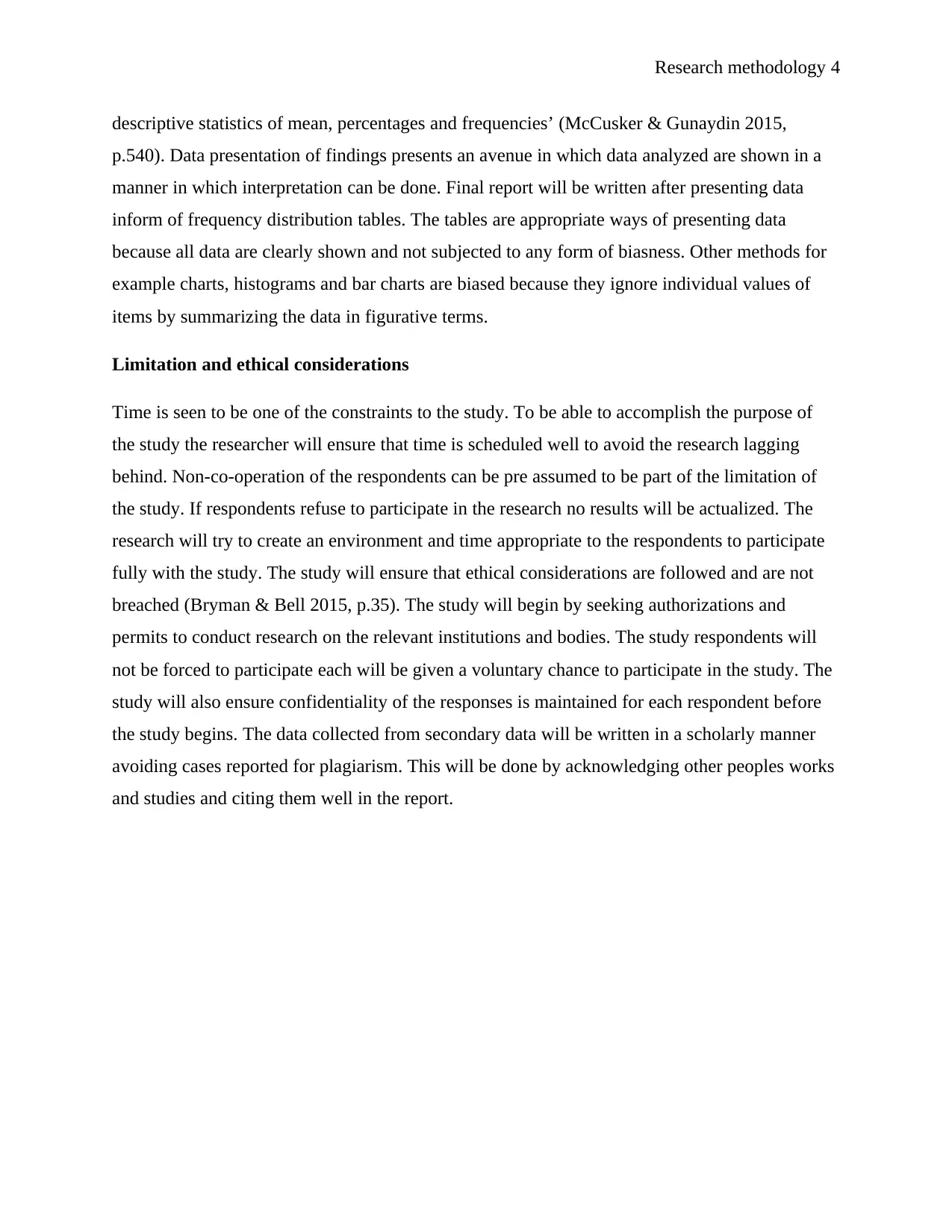
Research methodology 4
descriptive statistics of mean, percentages and frequencies’ (McCusker & Gunaydin 2015,
p.540). Data presentation of findings presents an avenue in which data analyzed are shown in a
manner in which interpretation can be done. Final report will be written after presenting data
inform of frequency distribution tables. The tables are appropriate ways of presenting data
because all data are clearly shown and not subjected to any form of biasness. Other methods for
example charts, histograms and bar charts are biased because they ignore individual values of
items by summarizing the data in figurative terms.
Limitation and ethical considerations
Time is seen to be one of the constraints to the study. To be able to accomplish the purpose of
the study the researcher will ensure that time is scheduled well to avoid the research lagging
behind. Non-co-operation of the respondents can be pre assumed to be part of the limitation of
the study. If respondents refuse to participate in the research no results will be actualized. The
research will try to create an environment and time appropriate to the respondents to participate
fully with the study. The study will ensure that ethical considerations are followed and are not
breached (Bryman & Bell 2015, p.35). The study will begin by seeking authorizations and
permits to conduct research on the relevant institutions and bodies. The study respondents will
not be forced to participate each will be given a voluntary chance to participate in the study. The
study will also ensure confidentiality of the responses is maintained for each respondent before
the study begins. The data collected from secondary data will be written in a scholarly manner
avoiding cases reported for plagiarism. This will be done by acknowledging other peoples works
and studies and citing them well in the report.
descriptive statistics of mean, percentages and frequencies’ (McCusker & Gunaydin 2015,
p.540). Data presentation of findings presents an avenue in which data analyzed are shown in a
manner in which interpretation can be done. Final report will be written after presenting data
inform of frequency distribution tables. The tables are appropriate ways of presenting data
because all data are clearly shown and not subjected to any form of biasness. Other methods for
example charts, histograms and bar charts are biased because they ignore individual values of
items by summarizing the data in figurative terms.
Limitation and ethical considerations
Time is seen to be one of the constraints to the study. To be able to accomplish the purpose of
the study the researcher will ensure that time is scheduled well to avoid the research lagging
behind. Non-co-operation of the respondents can be pre assumed to be part of the limitation of
the study. If respondents refuse to participate in the research no results will be actualized. The
research will try to create an environment and time appropriate to the respondents to participate
fully with the study. The study will ensure that ethical considerations are followed and are not
breached (Bryman & Bell 2015, p.35). The study will begin by seeking authorizations and
permits to conduct research on the relevant institutions and bodies. The study respondents will
not be forced to participate each will be given a voluntary chance to participate in the study. The
study will also ensure confidentiality of the responses is maintained for each respondent before
the study begins. The data collected from secondary data will be written in a scholarly manner
avoiding cases reported for plagiarism. This will be done by acknowledging other peoples works
and studies and citing them well in the report.
Paraphrase This Document
Need a fresh take? Get an instant paraphrase of this document with our AI Paraphraser
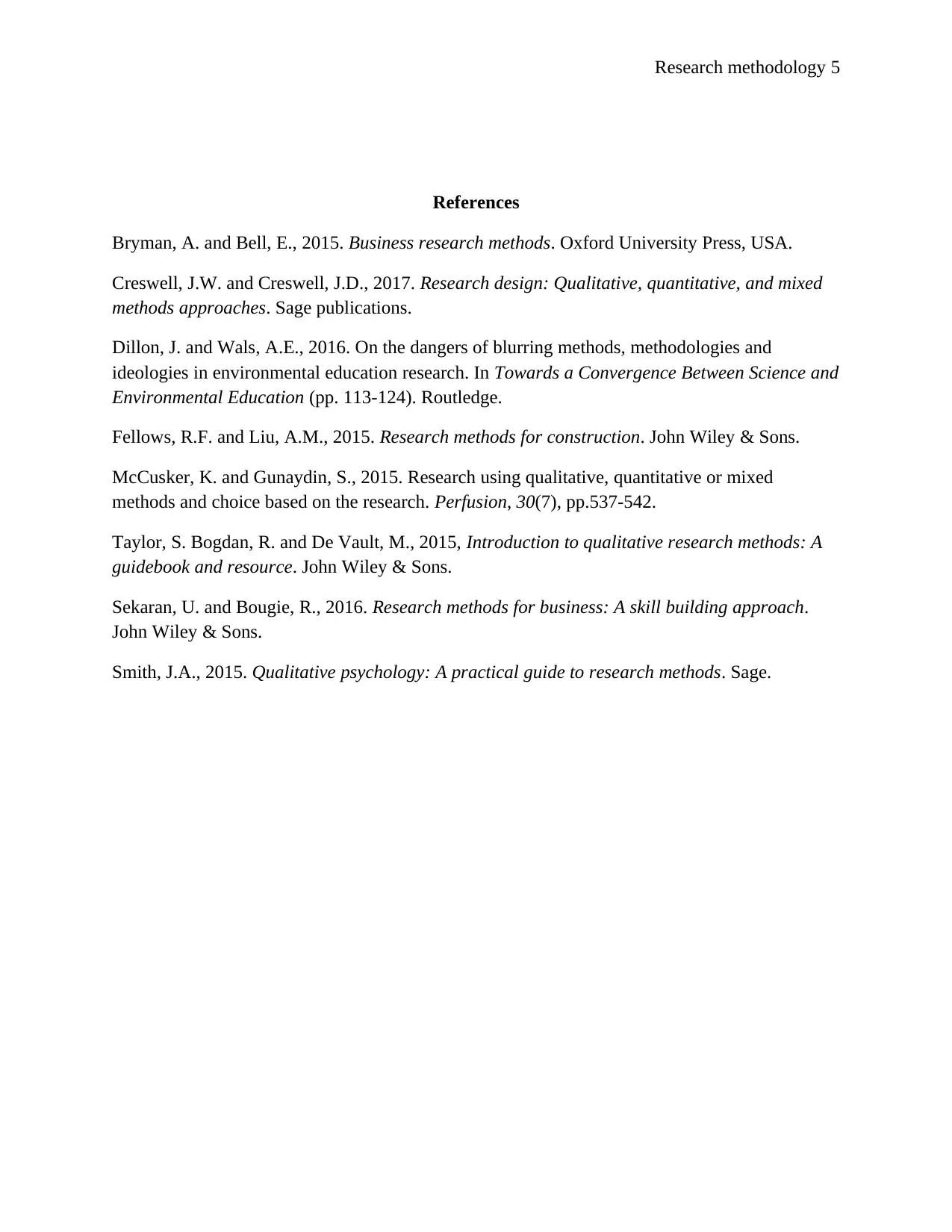
Research methodology 5
References
Bryman, A. and Bell, E., 2015. Business research methods. Oxford University Press, USA.
Creswell, J.W. and Creswell, J.D., 2017. Research design: Qualitative, quantitative, and mixed
methods approaches. Sage publications.
Dillon, J. and Wals, A.E., 2016. On the dangers of blurring methods, methodologies and
ideologies in environmental education research. In Towards a Convergence Between Science and
Environmental Education (pp. 113-124). Routledge.
Fellows, R.F. and Liu, A.M., 2015. Research methods for construction. John Wiley & Sons.
McCusker, K. and Gunaydin, S., 2015. Research using qualitative, quantitative or mixed
methods and choice based on the research. Perfusion, 30(7), pp.537-542.
Taylor, S. Bogdan, R. and De Vault, M., 2015, Introduction to qualitative research methods: A
guidebook and resource. John Wiley & Sons.
Sekaran, U. and Bougie, R., 2016. Research methods for business: A skill building approach.
John Wiley & Sons.
Smith, J.A., 2015. Qualitative psychology: A practical guide to research methods. Sage.
References
Bryman, A. and Bell, E., 2015. Business research methods. Oxford University Press, USA.
Creswell, J.W. and Creswell, J.D., 2017. Research design: Qualitative, quantitative, and mixed
methods approaches. Sage publications.
Dillon, J. and Wals, A.E., 2016. On the dangers of blurring methods, methodologies and
ideologies in environmental education research. In Towards a Convergence Between Science and
Environmental Education (pp. 113-124). Routledge.
Fellows, R.F. and Liu, A.M., 2015. Research methods for construction. John Wiley & Sons.
McCusker, K. and Gunaydin, S., 2015. Research using qualitative, quantitative or mixed
methods and choice based on the research. Perfusion, 30(7), pp.537-542.
Taylor, S. Bogdan, R. and De Vault, M., 2015, Introduction to qualitative research methods: A
guidebook and resource. John Wiley & Sons.
Sekaran, U. and Bougie, R., 2016. Research methods for business: A skill building approach.
John Wiley & Sons.
Smith, J.A., 2015. Qualitative psychology: A practical guide to research methods. Sage.
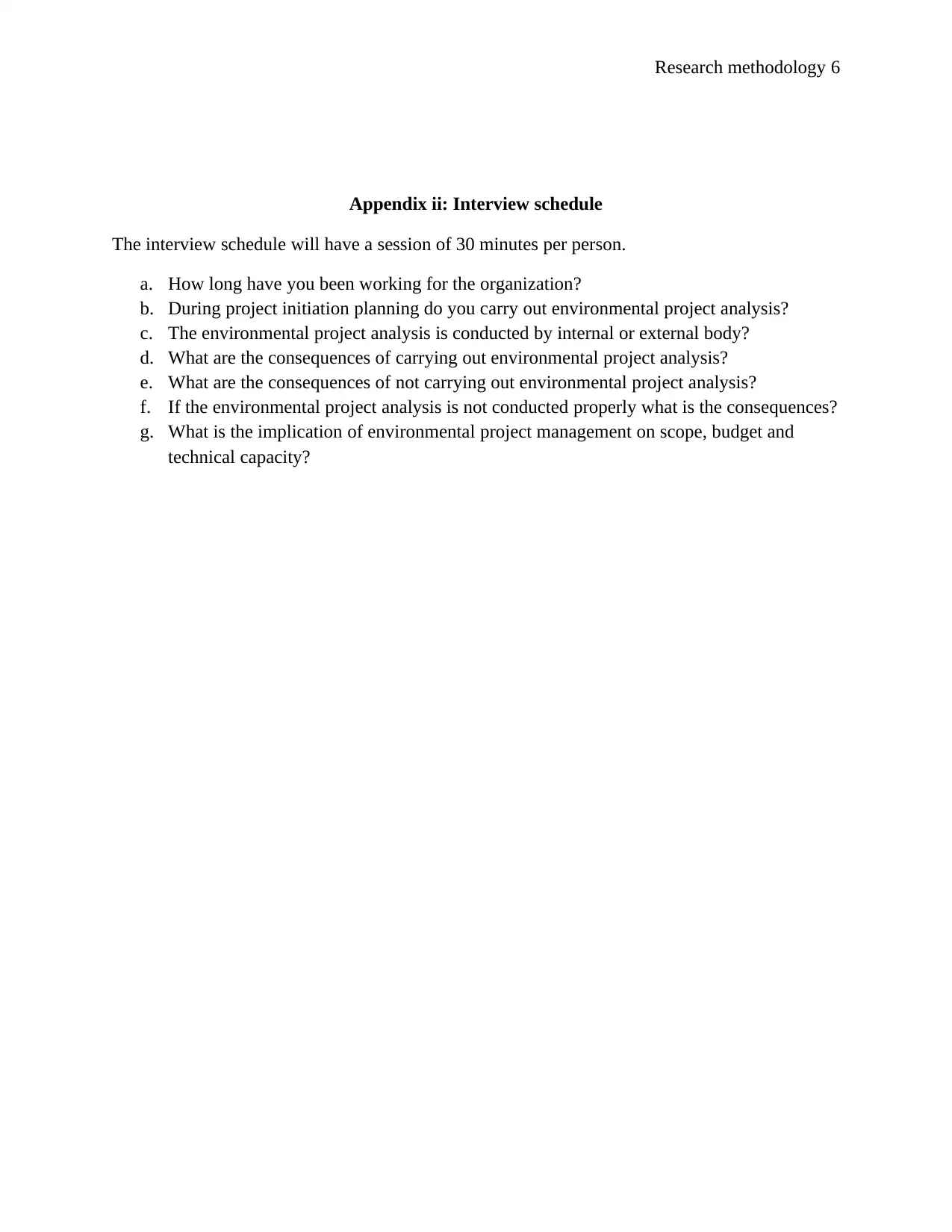
Research methodology 6
Appendix ii: Interview schedule
The interview schedule will have a session of 30 minutes per person.
a. How long have you been working for the organization?
b. During project initiation planning do you carry out environmental project analysis?
c. The environmental project analysis is conducted by internal or external body?
d. What are the consequences of carrying out environmental project analysis?
e. What are the consequences of not carrying out environmental project analysis?
f. If the environmental project analysis is not conducted properly what is the consequences?
g. What is the implication of environmental project management on scope, budget and
technical capacity?
Appendix ii: Interview schedule
The interview schedule will have a session of 30 minutes per person.
a. How long have you been working for the organization?
b. During project initiation planning do you carry out environmental project analysis?
c. The environmental project analysis is conducted by internal or external body?
d. What are the consequences of carrying out environmental project analysis?
e. What are the consequences of not carrying out environmental project analysis?
f. If the environmental project analysis is not conducted properly what is the consequences?
g. What is the implication of environmental project management on scope, budget and
technical capacity?
⊘ This is a preview!⊘
Do you want full access?
Subscribe today to unlock all pages.

Trusted by 1+ million students worldwide
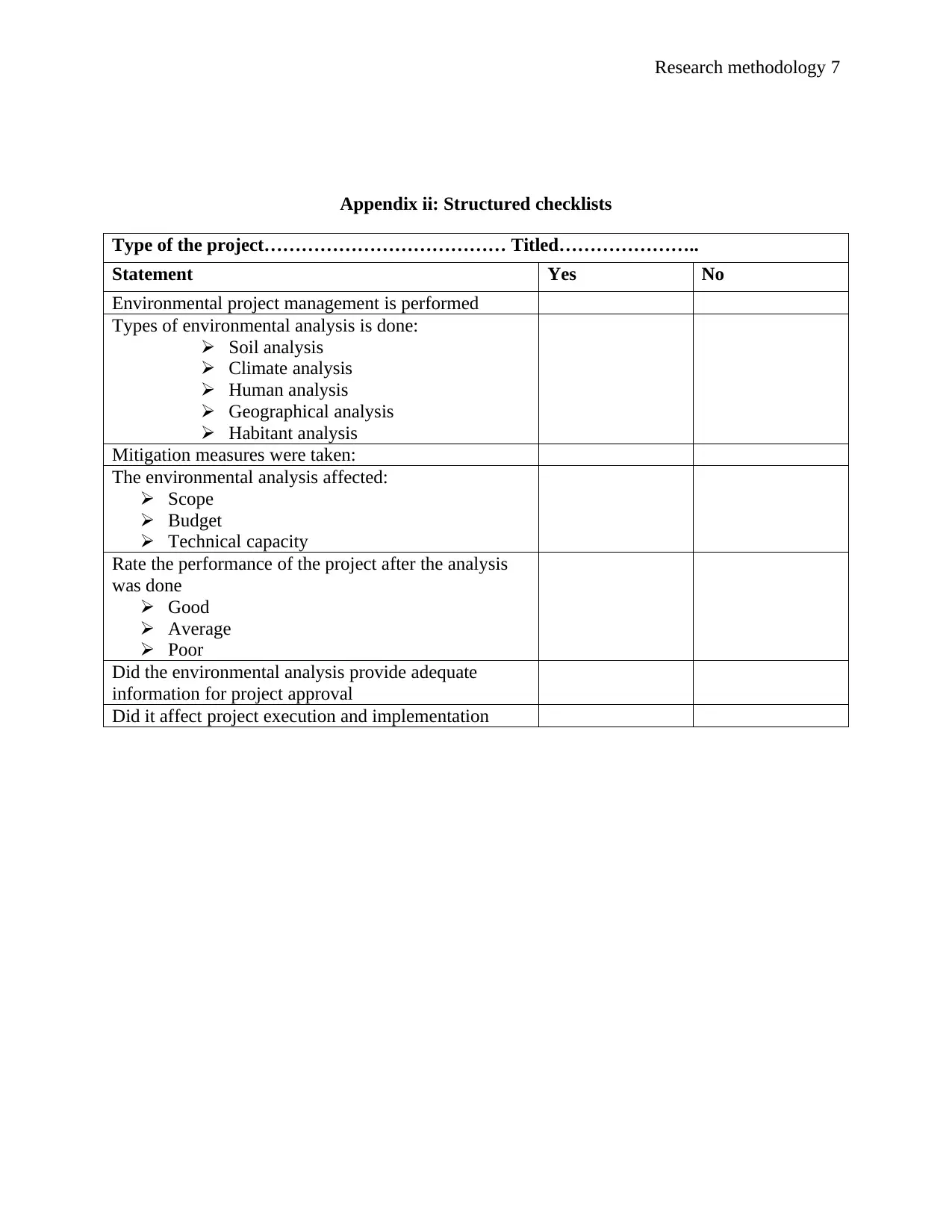
Research methodology 7
Appendix ii: Structured checklists
Type of the project………………………………… Titled…………………..
Statement Yes No
Environmental project management is performed
Types of environmental analysis is done:
Soil analysis
Climate analysis
Human analysis
Geographical analysis
Habitant analysis
Mitigation measures were taken:
The environmental analysis affected:
Scope
Budget
Technical capacity
Rate the performance of the project after the analysis
was done
Good
Average
Poor
Did the environmental analysis provide adequate
information for project approval
Did it affect project execution and implementation
Appendix ii: Structured checklists
Type of the project………………………………… Titled…………………..
Statement Yes No
Environmental project management is performed
Types of environmental analysis is done:
Soil analysis
Climate analysis
Human analysis
Geographical analysis
Habitant analysis
Mitigation measures were taken:
The environmental analysis affected:
Scope
Budget
Technical capacity
Rate the performance of the project after the analysis
was done
Good
Average
Poor
Did the environmental analysis provide adequate
information for project approval
Did it affect project execution and implementation
1 out of 7
Related Documents
Your All-in-One AI-Powered Toolkit for Academic Success.
+13062052269
info@desklib.com
Available 24*7 on WhatsApp / Email
![[object Object]](/_next/static/media/star-bottom.7253800d.svg)
Unlock your academic potential
Copyright © 2020–2025 A2Z Services. All Rights Reserved. Developed and managed by ZUCOL.





